Porsche Panamera
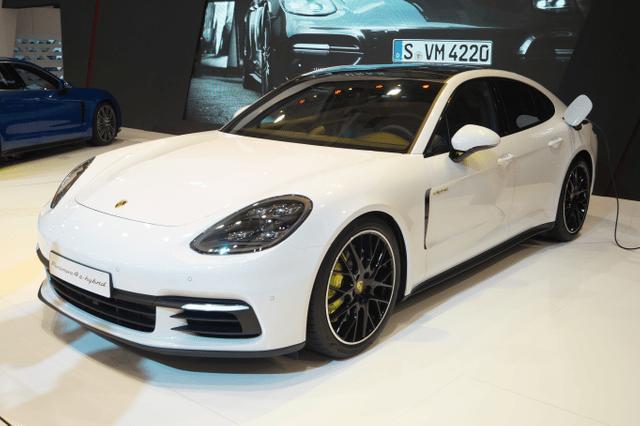
Porsche Panamera

| Porsche Panamera | |
|---|---|
| Overview | |
| Manufacturer | Porsche AG |
| Production | 2009–present |
| Model years | 2010–present |
| Body and chassis | |
| Class | Full-size luxury car (F) |
| Layout | Front-engine, rear-wheel-drive / four-wheel-drive |
| First generation (970) Chassis G1 | |
 Porsche Panamera 4S (pre-facelift) | |
| Overview | |
| Production | April 2009–2016 |
| Model years | 2010–2016 |
| Assembly | Germany: Leipzig |
| Designer | Michael Mauer |
| Body and chassis | |
| Body style | 5-door liftback[1][13][14][15][16] |
| Powertrain | |
| Engine |
|
| Transmission |
|
| Dimensions | |
| Wheelbase | 2,900 mm (114.2 in) 3,070 mm (120.9 in) (LWB) |
| Length | 4,970 mm (195.7 in) 5,165 mm (203.3 in) (LWB) |
| Width | 1,931 mm (76.0 in) |
| Height | 1,418 mm (55.8 in) 1,425 mm (56.1 in) (LWB) |
| Curb weight | 1,770–2,055 kg (3,902–4,530 lb) |
| Second generation (971) Chassis G2 | |
 | |
| Overview | |
| Production | 2016–present |
| Model years | 2017–present |
| Assembly | Germany: Leipzig |
| Body and chassis | |
| Body style | 5-door liftback 5-door estate |
| Platform | Volkswagen Group MSB |
| Related | Mercedes-AMG GT 4-Door Coupé Bentley Continental GT (2018) Bentley Flying Spur (2019) |
| Powertrain | |
| Engine |
|
| Transmission | 8-speed PDK |
| Dimensions | |
| Wheelbase | 2,950 mm (116.1 in) 3,100 mm (122.0 in) (LWB) |
| Length | 5,049 mm (198.8 in) 5,199 mm (204.7 in) (LWB) |
| Width | 1,937 mm (76.3 in) |
| Height | 1,423 mm (56.0 in) 1,432 mm (56.4 in) (LWB) |
| Curb weight | 1,815–2,310 kg (4,001–5,093 lb) |
The Porsche Panamera is a full-sized luxury vehicle (F-segment in Europe) manufactured by the German automobile manufacturer Porsche.[1][2][3] It is front-engined and has a rear-wheel-drive layout, with all-wheel drive versions also available. It is the only sedan manufactured by Porsche as part of its strategy of expanding its market.
The production version of the Porsche Panamera was unveiled at the 13th Auto Shanghai International Automobile Show in Shanghai, China, on April 2009.[4] In 2011, hybrid and diesel versions were launched. In April 2013, a facelift to the Panamera was announced, making its debut again at the Shanghai Auto Show.[5] A plug-in hybrid version, the Panamera S E-Hybrid, was released in the U.S. market in November 2013.[6] The Panamera range received a re-design in 2016.
| Porsche Panamera | |
|---|---|
| Overview | |
| Manufacturer | Porsche AG |
| Production | 2009–present |
| Model years | 2010–present |
| Body and chassis | |
| Class | Full-size luxury car (F) |
| Layout | Front-engine, rear-wheel-drive / four-wheel-drive |
| First generation (970) Chassis G1 | |
 Porsche Panamera 4S (pre-facelift) | |
| Overview | |
| Production | April 2009–2016 |
| Model years | 2010–2016 |
| Assembly | Germany: Leipzig |
| Designer | Michael Mauer |
| Body and chassis | |
| Body style | 5-door liftback[1][13][14][15][16] |
| Powertrain | |
| Engine |
|
| Transmission |
|
| Dimensions | |
| Wheelbase | 2,900 mm (114.2 in) 3,070 mm (120.9 in) (LWB) |
| Length | 4,970 mm (195.7 in) 5,165 mm (203.3 in) (LWB) |
| Width | 1,931 mm (76.0 in) |
| Height | 1,418 mm (55.8 in) 1,425 mm (56.1 in) (LWB) |
| Curb weight | 1,770–2,055 kg (3,902–4,530 lb) |
| Second generation (971) Chassis G2 | |
 | |
| Overview | |
| Production | 2016–present |
| Model years | 2017–present |
| Assembly | Germany: Leipzig |
| Body and chassis | |
| Body style | 5-door liftback 5-door estate |
| Platform | Volkswagen Group MSB |
| Related | Mercedes-AMG GT 4-Door Coupé Bentley Continental GT (2018) Bentley Flying Spur (2019) |
| Powertrain | |
| Engine |
|
| Transmission | 8-speed PDK |
| Dimensions | |
| Wheelbase | 2,950 mm (116.1 in) 3,100 mm (122.0 in) (LWB) |
| Length | 5,049 mm (198.8 in) 5,199 mm (204.7 in) (LWB) |
| Width | 1,937 mm (76.3 in) |
| Height | 1,423 mm (56.0 in) 1,432 mm (56.4 in) (LWB) |
| Curb weight | 1,815–2,310 kg (4,001–5,093 lb) |
Concept and description
The Panamera's name is derived, like the Porsche Carrera lineage, from the Carrera Panamericana race. The Panamera is generally considered to be the long-awaited fruit of Porsche's 989 concept vehicle from the late 1980s.
Like the Porsche Cayenne SUV (which has become the marque's best-selling vehicle), the Panamera upset many Porsche purists, since it was seen as an attempt to broaden Porsche's appeal beyond that of hardcore fans. The Panamera ran contrary to the company's signature offerings, particularly its light two-door rear-engine sports cars like the 911. The Panamera on the other hand is considered a full-size luxury car, weighing nearly 4,000 pounds (1,800 kg), with four doors, and its engine mounted in the front. The Panamera's appearance with its long hood and rear hatch bears resemblance to a stretched 911.[7] The 911 has a sparse interior, as it was focused on raw performance, while the Panamera has a sumptuous interior loaded with modern technological amenities and expensive leather upholstery.[8][9]
Production
Production began in April 2009, one month after its debut in the Shanghai Motor Show in China.[12]
First generation (2010–2016)
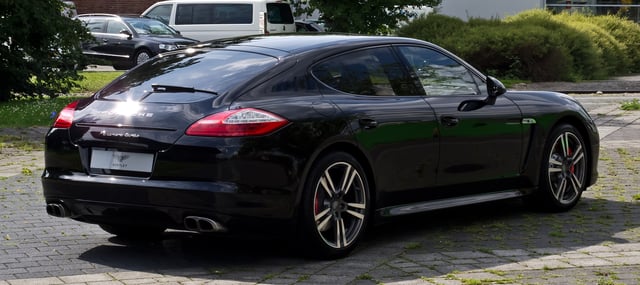
Porsche Panamera Turbo (pre-facelift)
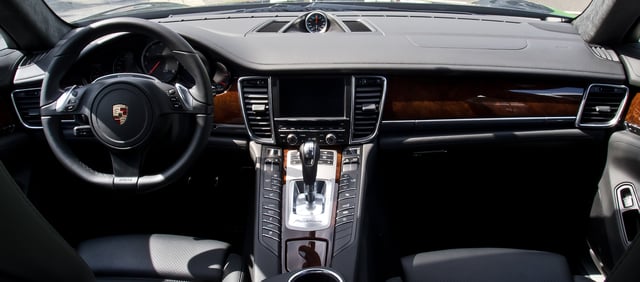
Interior
The V8-powered Panamera S, 4S, and Turbo models were the first versions that debuted in 2009. In addition to the 4.8L Twin Turbo 500 PS (368 kW; 493 hp) V8 powered models, Porsche launched two further models in 2010: the Panamera and Panamera 4 which are both powered by 3.0-litre and 3.6-litre V6 engines producing 300 PS (221 kW; 296 hp).
Being derived from the V8 engine of the Panamera S and Panamera 4S, the V6 retains the V8's technologies like Direct Fuel Injection, infinitely variable intake camshaft adjustment with variable valve lift (VarioCam Plus), an on-demand oil pump, water cooling with thermal management, a variable intake manifold, as well as integrated dry sump lubrication with two-stage extraction of oil, and an Auto Start-Stop function (only with the PDK transmission).[17] Turbo version uses active aerodynamics with a multi-stage, adjustable rear spoiler.[18] Optional Sports Chrono Packages include a Sport Plus button, which has tighter damping and air springs, and lowers the car's body by 25 mm (1.0 in).[19]
The Panamera, S, Hybrid and Diesel models are rear-wheel drive, while the Panamera 4, 4S, and GTS have the same four-wheel drive system as the Turbo and Turbo S, called Porsche Traction Management (PTM).
The Panamera featured Adaptive air suspension, the Porsche Dynamic Chassis Control (PDCC), active anti-roll bars[24] and the Porsche Active Suspension Management (PASM).
Engines
| car model | displacement & configuration | max. motive power at rpm | max. torque at rpm | max. speed | emissionsCO 2 |
|---|---|---|---|---|---|
| Panamera | 3.6 litre V6 | 300 PS (221 kW; 296 hp) at 6,200 | 400 N⋅m (295 lbf⋅ft) at 3,750–4,250 | 261 km/h (162 mph) | 265 g/km (manual) |
| Panamera 4 | 3.6 litre V6 | 300 PS (221 kW; 296 hp) at 6,200 | 400 N⋅m (295 lbf⋅ft) at 3,750–4,250 | 257 km/h (160 mph) | 225 g/km |
| Panamera Diesel | 3.0 litre V6 turbodiesel | 250 PS (184 kW; 247 hp) at 3,800 | 550 N⋅m (406 lbf⋅ft) at 1,750–2,750 | 244 km/h (152 mph) | 172 g/km |
| Panamera S | 4.8 litre V8 | 400 PS (294 kW; 395 hp) at 6,500 | 500 N⋅m (369 lbf⋅ft) at 3,500–5,000 | 285 km/h (177 mph) | 293 g/km (manual) |
| Panamera 4S | 4.8 litre V8 | 400 PS (294 kW; 395 hp) at 6,500 | 500 N⋅m (369 lbf⋅ft) at 3,500–5,000 | 282 km/h (175 mph) | 254 g/km |
| Panamera GTS | 4.8 litre V8 | 430 PS (316 kW; 424 hp) at 6,700 | 520 N⋅m (384 lbf⋅ft) at 3,500–5,000 | 288 km/h (179 mph) | 256 g/km |
| Panamera S Hybrid | 3.0 litre V6 supercharged | 380 PS (279 kW; 375 hp) at 5,500 | 580 N⋅m (428 lbf⋅ft) at 3,000–5,250 | 270 km/h (168 mph) | 167 g/km |
| Panamera Turbo | 4.8 litre V8 twin turbo | 500 PS (368 kW; 493 hp) at 6,000 | 700 N⋅m (516 lbf⋅ft) at 2,250–4,500 | 303 km/h (188 mph) | 270 g/km |
| Panamera Turbo S | 4.8 litre V8 twin turbo | 550 PS (405 kW; 542 hp) at 6,000 | 750 N⋅m (553 lbf⋅ft) at 2,250–4,500 | 306 km/h (190 mph) | 270 g/km |
Transmissions
The newly introduced ZF 7-speed PDK dual clutch transmission was standard on the Panamera 4, 4S and Turbo models.[25][26] The addition of the optional sport chrono package provided faster acceleration times. In some markets a 6-speed manual was available for rear-wheel drive petrol versions. The S Hybrid and Diesel models had an Aisin-supplied eight-speed automatic transmission called the Tiptronic S.
Panamera Turbo S
The engine of the Panamera Turbo S features larger turbochargers than the standard Panamera Turbo’s 4.8-litre V8, as well as high-pressure fuel injection, and aluminium-alloy pistons. The piston rings are coated in a low-friction surface to help eke out even more performance. The Panamera Turbo S accelerates to 62 mph in 3.8 seconds with launch control engaged. Roll-on acceleration should be more impressive, changes to the PDK (Porsche Doppelkupplung) gearbox allow for faster gearshifts, and the alleged 27.7mpg fuel economy is no worse than the less powerful Panamera Turbo.[27]
Panamera S Hybrid
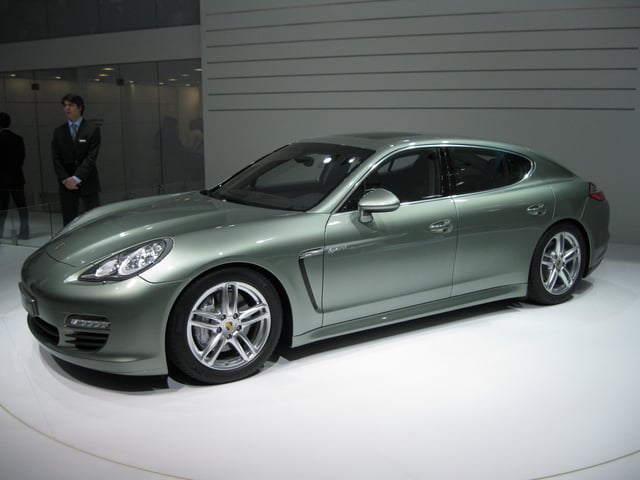
Porsche Panamera S Hybrid at the 2011 Geneva Auto Show
In 2008, Porsche AG announced the development of a parallel hybrid system for the Panamera,[29] and in February 2011, Porsche unveiled the Panamera S Hybrid. Using the same drivetrain seen in the Cayenne S Hybrid—an Audi-sourced[30] supercharged 3.0-litre V6 engine producing 333 PS (245 kW; 328 hp) along with an electric motor rated at 47 PS (35 kW; 46 hp), as well as the Cayenne's 8-speed Tiptronic S transmission—the 380 PS (279 kW; 375 hp) Panamera S Hybrid could accelerate from 0–62 mph in 6.0 seconds. The Panamera S Hybrid produced only 193 grams of carbon dioxide per kilometre, rendering it the most environment friendly car in the then entire Porsche model range,[31] while still maintaining a top speed of 167.8 mph (270 km/h).
Deliveries began in the United States in 2011, and cumulative sales reached 684 units through March 2013.[32][33] The U.S. Environmental Protection Agency (EPA) rated the fuel economy for the 2013/2012 model year Panamera Hybrid at 22 mpg‑US (11 L/100 km; 26 mpg‑imp) for city driving, 30 mpg‑US (7.8 L/100 km; 36 mpg‑imp) for highway, and 25 mpg‑US (9.4 L/100 km; 30 mpg‑imp) combined.[34]
Panamera Diesel
The Panamera Diesel was launched in May 2011. The vehicle utilised the same Audi 3.0L V6 engine used in the Cayenne Diesel, which was itself a tuned carryover of an existing engine. The engine had a power output of 250 PS (184 kW; 247 hp). The car was capable of accelerating from 0–62 mph in 6.8 seconds and had a top speed of 150.4 mph (242 km/h). It was also the most economical Porsche in the then entire Porsche vehicle lineage, consuming just 6.3 litres per 100 kilometres (37 US MPG/45 UK MPG).
Special editions
In October 2012, Porsche introduced the Panamera Platinum Edition. The exterior of the Panamera Platinum Edition was enveloped in one of five basic colours – black, white, basalt black, carbon grey metallic, and mahogany metallic. It included more standard equipment, larger wheels, and an exclusive interior leather combination of luxor beige and black. It was be offered with rear and all wheel drive layouts, and had a 0 to 60 mph (0 to 97 km/h) acceleration time of under 5.8 seconds or faster on all variants. Exclusive equipment included the special interior combination, platinum rear overhang and front lower grille, platinum door sills, and platinum mirrors. The finalizing touch to this special edition included an exclusive set of 19-inch Panamera Turbo alloy wheels with the red, black, and gold Porsche crest.
In March 2015, Porsche announced that they were releasing a new special edition Panamera called the "Panamera Edition". The car is based on the base Panamera and includes high-gloss black trim strips outline the windows,19-inch Panamera Turbo wheels with coloured centre caps, the sills were inscribed with the word "Edition," and body-coloured door handles were an additional add on when the customer chose the Porsche Entry & Drive option. The Panamera Edition cost 80,000 USD.
2013 facelift
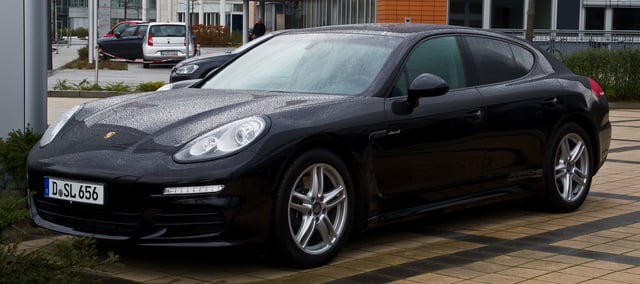
2013 facelift

2013 facelift
Porsche announced its updated Panamera on 3 April 2013, with a scheduled formal launch at Auto Shanghai. The revised model can be identified by new front and rear bumpers. Technical changes included the addition of a new 3.0L twin-turbocharged Panamera S and a new E-Hybrid model. A long wheelbase version with an additional 150 mm was available for selected left-hand drive markets. The Turbo S version followed up in 2014. The long wheelbase versions were only available on 4S, Turbo, and Turbo S models.[35]
Engines
| car model | displacement & configuration | max. motive power at rpm | max. torque at rpm | max. speed | emissionsCO 2 |
|---|---|---|---|---|---|
| Panamera | 3.6 litre (3605cc) V6 | 310 PS (228 kW; 306 bhp) at 6,200 | 400 N⋅m (295 lbf⋅ft) at 3,750 | 259 km/h (161 mph) | 196 g/km |
| Panamera 4 | 3.6 litre (3605cc) V6 | 310 PS (228 kW; 306 bhp) at 6,200 | 400 N⋅m (295 lbf⋅ft) at 3,750 | 257 km/h (160 mph) | 203 g/km |
| Panamera Diesel[36] | 3.0 litre (2967 cc) V6 turbodiesel | 300 PS (221 kW; 296 bhp) at 3,800-4,400 | 650 N⋅m (479 lbf⋅ft) at 1,750–2,750 | 259 km/h (161 mph) | 166 g/km |
| Panamera S | 3.0 litre (2997 cc) V6 twin turbo | 420 PS (309 kW; 414 bhp) at 6,000 | 520 N⋅m (384 lbf⋅ft) at 1,750–5,000 | 287 km/h (178 mph) | 204 g/km |
| Panamera 4S | 3.0 litre (2997 cc) V6 twin turbo | 420 PS (309 kW; 414 bhp) at 6,000 | 520 N⋅m (384 lbf⋅ft) at 1,750–5,000 | 286 km/h (178 mph) | 208 g/km |
| Panamera S E-Hybrid | 3.0 litre (2995cc) V6 supercharged | 333 PS (245 kW; 328 bhp) at 5,500 | 590 N⋅m (435 lbf⋅ft) at 1,250–4,000 | 270 km/h (168 mph) | 71 g/km |
| Panamera GTS | 4.8 litre (4806cc) V8 | 434 PS (319 kW; 428 bhp) at 6,700 | 520 N⋅m (384 lbf⋅ft) at 3,500 | 288 km/h (179 mph) | 249 g/km |
| Panamera Turbo | 4.8 litre (4806cc) V8 twin turbo | 520 PS (382 kW; 513 bhp) at 6,000 | 700 N⋅m (516 lbf⋅ft) at 2,250–4,500 | 305 km/h (190 mph) | 239 g/km |
| Panamera Turbo S | 4.8 litre (4806cc) V8 twin turbo | 570 PS (419 kW; 562 bhp) at 6,000 | 750 N⋅m (553 lbf⋅ft) at 2,250–4,500 | 309 km/h (192 mph) | 239 g/km |
| Panamera Turbo S Executive | 4.8 litre (4806cc) V8 twin turbo | 570 PS (419 kW; 562 bhp) at 6,000 | 800 N⋅m (590 lbf⋅ft) at 2,250–4,500 | 310 km/h (193 mph) | 242 g/km |
Panamera S E-Hybrid
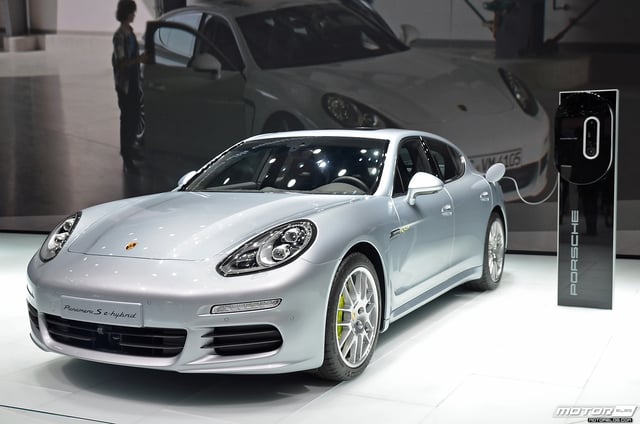
Retail deliveries of the Panamera S E-Hybrid began in the U.S. in October 2013.
As part of the 2013 Panamera facelift, Porsche announced the introduction of a plug-in hybrid model, the Panamera S E-Hybrid. The plug-in version was unveiled at the April 2013 Shanghai Auto Show.[37][38] The S E-Hybrid is powered by a 71 kW (97 PS; 95 bhp) electric motor, with a total system power of 310 kW (421 PS; 416 bhp). Top speed amounted to 84 mph (135 km/h) in all-electric mode, and acceleration from 0–62mph took 5.8 seconds. The plug-in electric hybrid had a 9.4 kWh lithium-ion battery pack capable of delivering a range of more than 32 km (20 mi) under the New European Driving Cycle (NEDC) standard. The battery could be fully charged in approximately 2½ hours from a 240 V power source. The Panamera plug-in hybrid reduce fuel consumption to 3.1 L/100 km (91 mpg‑imp; 76 mpg‑US), down from 7.11 L/100 km (39.7 mpg‑imp; 33.1 mpg‑US) for the current Panamera hybrid, which translates to CO2 emissions of 71 g/km, down from 167 g/km for the current hybrid.[37][38]
In November 2013, the UK Office for Low Emission Vehicles (OLEV) approved the eligibility of the Panamera S E-Hybrid for the Plug-in Car Grant which entitles customers to a maximum purchase subsidy of GB£5,000 ( ~ US$8,000). The plug-in hybrid was rated with a fuel economy of 91 mpg‑imp (3.1 L/100 km; 76 mpg‑US) and CO2 emissions of 71 g/km.[39]
EPA fuel economy ratings
| Vehicle | Model year | Operating mode (AER) | EPA fuel economy ratings[40] | Cost to drive 25 miles | Annual Fuel Cost(1) (15,000 mi) | ||
|---|---|---|---|---|---|---|---|
| Combined | City | Highway | |||||
| Panamera S E-Hybrid | 2014 | Electricity and gasoline (16 mi)(2) | 50 mpg-e (52 kWh/100 mi) | US$3.55 | US$1,900 | ||
| Gasoline only | 25 mpg | 23 mpg | 29 mpg | US$3.90 | |||
| Porsche Panamera S | 2014 | Gasoline only | 21 mpg | 17 mpg | 27 mpg | US$4.64 | US$2,800 |
| Porsche Panamera Turbo | 2014 | Gasoline only | 18 mpg | 15 mpg | 24 mpg | US$5.42 | US$3,250 |
| Porsche Panamera Turbo S | 2014 | Gasoline only | 18 mpg | 15 mpg | 24 mpg | US$5.42 | US$3,250 |
| Notes: (1) Based on 45% highway and 55% city driving. Values rounded to the nearest $50. Electricity cost ofUS$0.12/kWh, premium gasoline price ofUS$3.90per gallon (as of 4 April 2014). Conversion 1 gallon of gasoline=33.7 kWh. (2) The all-electric range is between 0 and 15 mi[40] | |||||||
Markets and sales
The Panamera S E-Hybrid was released in the European market during the fourth quarter of 2013. Retail deliveries began in the U.S. in October 2013.[6] As of December 2013, a total of 90 units were delivered in France,[41] 86 units in the United States,[42] 59 units in the Netherlands,[43] 14 in Spain,[44] and about 12 in Germany.[45]
In the American market the 2014 model year price starts at US$99,000 before any applicable government incentives.[46] Since its introduction, 698 Panamera S E-Hybrids have been sold in the United States through August 2014.[47] Global sales between January and August 2014 totaled over 1,500 units, presenting 9% of all Panamera models sold worldwide and 1.3% of all Porsche vehicles sold during this period.[48]
Second generation (2017–present)

Porsche Panamera Turbo fastback sedan (Europe)
The second generation Panamera was revealed on 28 June 2016 at a special event in Berlin, Germany. Codenamed 971,[49] it is 35 mm (1.4 in) longer, 5 mm (0.2 in) wider and 5 mm (0.2 in) taller than the first generation Panamera, with a 30 mm (1.2 in) longer wheelbase. The interior features a redesigned dashboard layout, with touch-sensitive surfaces replacing the previous generation’s array of buttons. A centrally mounted tachometer also harks back to the 1955 Porsche 356 A.
The new car includes two seven-inch displays in place of the dials, as well as a 12.3-inch touchscreen featuring online sat-nav, Apple CarPlay integration and an updated voice control system. Under the bonnet is a new engine range, with only the Panamera 4S, 4S Diesel and flagship Turbo[50] available from launch. [51]
In March 2017, Porsche unveiled the Panamera Turbo S E-Hybrid, a plug-in hybrid for the 2018 model year. The Turbo S E-Hybrid will receive the 4.0 L V8 engine from the Panamera Turbo, but will also be paired with an electric motor. Total system power will be 680 PS (500 kW; 671 bhp), which makes it the third most powerful Porsche ever, after the 918 Spyder and 991 GT2RS.[52]
In August 2017, Panamera 4S Diesel and Panamera Sport Turismo 4S Diesel were deleted from Porsche's German website and configurator. The German automotive magazine, auto motor und sport, discovered the higher than permittable amount, which is one-and-half times more than legal limit, during the exhaust testing.[53] The issue was with SCR catalysator and urea injection. In September 2018 Porsche announced that the company had decided to no longer offer diesel propulsion in future.[54]
Exterior design
The new Panamera no longer has its predecessor's oft-criticized hatchback wagon styling, with the tail of the new vehicle developing a clear link to the Porsche 911 through the full width rear LED light bar, and the sharply creased tail and upper bumper.[55] This improvement in design has helped clarify the model's identity as a sports-oriented GT car.[55]
Sport Turismo
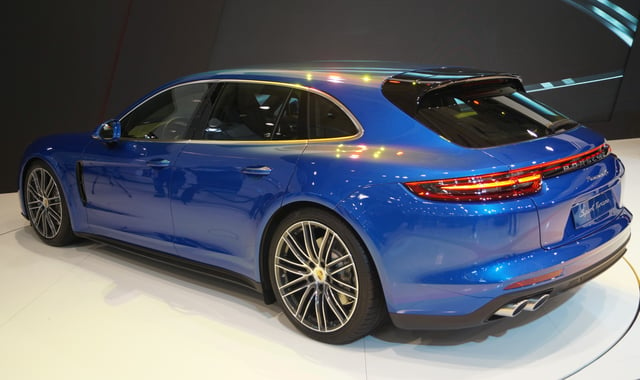
Side view of the Porsche Panamera Sport Turismo
In Europe a 5-door, shooting-brake estate variant, called the Sport Turismo, will be offered alongside the liftback saloon. It will also be available in the United States.[56] The Panamera Sport Turismo debuted in March 2017 at the Geneva Motor Show, and is currently available with the same engine range as the 4-door car. In September 2017 Porsche announced the Panamera Turbo S E-Hybrid Sport Turismo, the 5-door estate version of the flagship Turbo S E-Hybrid, which had previously only been available as a 4-door configuration.[57] As of September 2017, the 680 PS (500 kW; 671 bhp) Panamera Turbo S E-Hybrid Sport Turismo is currently the world's most powerful stock estate car, besting the 612 PS (450 kW; 604 bhp) Mercedes-AMG E 63 S and the 605 PS (445 kW; 597 bhp) Audi RS6 Performance.[58]
Engines
| Car Model | Years | Powertrain | Max. Power | Max. Torque |
|---|---|---|---|---|
| Panamera 4 | 2016- | Turbocharged V6, 2995 cc, petrol | 330 PS (243 kW; 325 bhp) at 5400-6400 rpm | 450 N⋅m (332 lb⋅ft) at 1340-4900 rpm |
| Panamera 4 E-Hybrid | 2016- | Twin-turbocharged V6, 2894 cc, petrol (with electric motor) | Combustion Engine: 330 PS (243 kW; 325 bhp) at 5250-6500 rpm Electric Motor: 136 PS (100 kW; 134 bhp) at 2800 rpm System Output: 462 PS (340 kW; 456 bhp) at 6000 rpm | Combustion Engine: 450 N⋅m (332 lb⋅ft) at 1750-5000 rpm Electric Motor: 400 N⋅m (295 lb⋅ft) at < 2300 rpm System Output: 700 N⋅m (516 lb⋅ft) at 1100-4500 rpm |
| Panamera 4S | 2016- | Twin-turbocharged V6, 2894 cc, petrol | 440 PS (324 kW; 434 bhp) at 5650-6600 rpm | 550 N⋅m (406 lb⋅ft) at 1750-5500 rpm |
| Panamera GTS | 2019- | Twin-turbocharged V8, 3996 cc, petrol | 460 PS (338 kW; 454 bhp) at 5750-6000 rpm | 620 N⋅m (457 lb⋅ft) at 1960-4500 rpm |
| Panamera Turbo | 2016- | Twin-turbocharged V8, 3996 cc, petrol | 550 PS (405 kW; 542 bhp) at 5750-6000 rpm | 770 N⋅m (568 lb⋅ft) at 1960-4500 rpm |
| Panamera Turbo S E-Hybrid | 2017- | Twin-turbocharged V8, 3996 cc, petrol (with electric motor) | Combustion Engine: 550 PS (405 kW; 542 bhp) at 5750-6000 rpm Electric Motor: 136 PS (100 kW; 134 bhp) at 2800 rpm System Output: 680 PS (500 kW; 671 bhp) at 6000 rpm | Combustion Engine: 770 N⋅m (568 lb⋅ft) at 1960-4500 rpm Electric Motor: 400 N⋅m (295 lb⋅ft) at < 2300 rpm System Output: 850 N⋅m (627 lb⋅ft) at 1400-5500 rpm |
Performance
| Car Model | Powertrain | 0 to 100 km/h (62 mph) | Top Speed | CO2emissions |
|---|---|---|---|---|
| Panamera | 3.0L V6 turbo petrol | 5.5 s | 264 km/h (164 mph) | 171-173 g/km |
| Panamera 4 | 3.0L V6 turbo petrol | 5.3 s | 262 km/h (163 mph) | 175-177 g/km |
| Panamera 4 E-Hybrid | 2.9L V6 twin-turbo petrol | 4.6 s | 278 km/h (173 mph) | 56 g/km |
| Panamera 4S | 2.9L V6 twin-turbo petrol | 4.2 s | 289 km/h (180 mph) | 184-186 g/km |
| Panamera Turbo | 4.0L V8 twin-turbo petrol | 3.6 s | 306 km/h (190 mph) | 212-214 g/km |
| Panamera Turbo S E-Hybrid | 4.0L V8 twin-turbo petrol | 3.4 s | 310 km/h (193 mph) | 66 g/km |
Reception
Despite the differences in dimensions and design, a reviewer noted that the Panamera's driving dynamics were close to that of the 911, and it "seems to occupy the no-man's-land between really good sports sedans and proper sports cars", and so far the Panamera has won some comparison tests against other four-door performance cars on the market such as the Maserati Quattroporte and Aston Martin Rapide.[59][60] Function was also praised, with the 15.7 cubic feet (440 L) hatchback trunk, and the four-corner adaptive air suspension that retained superior handling while also providing a comfortable ride for public roads. Edmunds stated that the Panamera was an innovative engineering feat that "makes a unique statement about the way that luxury transportation and serious high-performance potential can be mixed together in one car".[8][9]
Unlike most of the V8-engined contemporaries, all models of the Panamera avoid the US Gas Guzzler Tax. The V6-powered Panamera was also praised, as its smaller engine still retained respectable acceleration,[61] and as it had even better handling than its V8 siblings, due to the engine being lighter by 100 lb (45 kg) which gave the car better weight distribution.[62]
However, CAR magazine of the U.K. described the S model as lacking sportiness, which they attributed to their test car's being "about as oriented to comfort as it’s possible to get"[63] and called the Turbo model "a missed opportunity on behalf of Porsche" to be "the world’s first lightweight four seater" as the top model weighs as much as an Audi S8.[64]
The 30 November 2008 edition of BBC's Top Gear featured a look at the Panamera in its news section, with the three presenters being very critical of the look. In the June 2009 edition, Richard Hammond and James May were seen driving the Panamera along the A30 in Devon, Great Britain. They were racing against a letter sent via Royal Mail between the Isles of Scilly and the Orkney Islands. Jeremy Clarkson reviewed the Porsche Panamera for an article with The Times newspaper and was quite critical.[65]
Sales
As of 2011, the largest national market was the United States with 6188 sold.[66] Sales by cities: Los Angeles (890), New York (760), Hong Kong (300), Dubai (285), Tokyo (223), Munich (206), Moscow (203), Shanghai (188), Hamburg (117) and Berlin (108).[67] Sales internationally by model variant: Panamera 4S (9394), Turbo (6171), S (4563) and V6 (2390—introduced weeks earlier).[66]
Publicity
On 20 April 2007, a spy video of the Porsche Panamera became available on the Internet.[70]
In September 2008, Porsche released the first teaser image for the Panamera.[71] In early October 2008, an undisguised Panamera was captured on film in Busan, South Korea.[72]
On 28 November 2008, Porsche sent a mailer containing two photos of the Panamera which were labeled as "the first official images of the Porsche Panamera" with an invitation to have online access to via Porsche USA's website.[73]
An estate version concept of the Panamera was introduced at the 2012 Paris Motor Show called Sport Turismo.[76] Powered by an advancement of Porsche's current hybrid system utilized in the Panamera S Hybrid, the Sport Turismo concept's new "e-Hybrid" system uses the 333-horsepower, supercharged 3.0-litre V6 and a 95-horsepower electric motor for 416 combined horses and a 30-kilometer electric range. As opposed to the current production system, this e-Hybrid setup prioritizes all-electric motivation unless the driver instructs the car otherwise. The Sport Turismo is technically a plug-in hybrid since the lithium-ion battery pack can be fully charged in as little as 2.5 hours when plugged into a wall outlet. Porsche declares that the combined powertrain is proficient for 0-62 mph acceleration in less than six seconds, and that the Sport Turismo can exceed 80 mph while running purely on electric power.[77]




